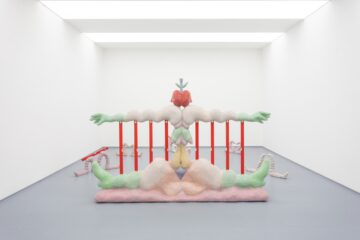Zsófia Keresztes (1985) presents her latest monumental sculptures to the Hungarian audience in her first solo exhibition at acb Gallery. Keresztes’ exhibition at acb follows her participation in the 2022 Venice Biennale. Her works that debuted at the Hungarian Pavilion in Venice can be seen in the Ludwig Museum in Budapest until 26 February, simultaneously with this exhibition.
Over the past decade, Zsófia Keresztes has become the most internationally known and exhibited artist of her generation, as evidenced not only by her participation in Venice, but also in the biennials of Lyon, Timisoara and Ljubljana as well as the Baltic Triennial in Vilnius, among others. Keresztes graduated from the Hungarian University of Fine Arts in 2010 as a painter, but her attention was drawn to textile and paper objects from an early age.
The artist sensitively combines the themes of sensuality and virtuality in her creative practice. Zsófia Keresztes often works with digital and psychological references in her works emerging from trash aesthetics. The stylistic features of the artist’s recent works also seem to be a combination of a fictional tribal culture that spans across the ages, Art Nouveau with its penchant for mosaics, and Surrealism.
Part of the group of works on show at acb Gallery has already been included in a group exhibition at CAN in Neuchatel. The new sculptures show stronger figurative characteristics than ever before: the typically formless, androgynous figures of Keresztes have now been extended with pronounced feminine features, and their iconography, based on the motif of the apple, is more narrative than before.
Keresztes’ giant totems can be interpreted either from the perspective of the Bible or from the archaic figure of the Venus of Willendorf. And the red spirit levels are a spectacular new complement to the sculptures, which are also reinterpreted as fences, while expressing the desire for balance. This solo exhibition marks the beginning of a collaboration between the artist and acb Gallery.
